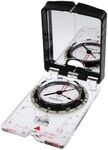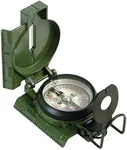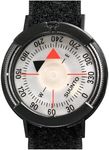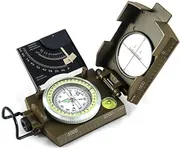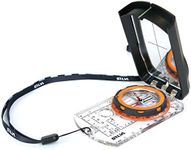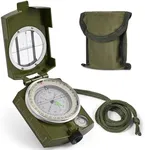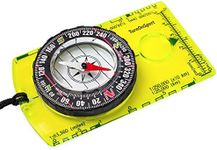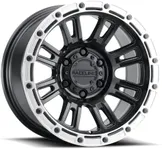Buying Guide for the Best Hiking Compasses
Choosing the right hiking compass is essential for ensuring you can navigate safely and accurately in the great outdoors. A good compass will help you find your way, even when visibility is poor or you're in unfamiliar territory. When selecting a hiking compass, it's important to consider several key specifications to ensure it meets your needs and preferences. Here are the main specs to look at and how to choose the best one for you.Type of CompassThere are several types of compasses, including baseplate, lensatic, and digital compasses. Baseplate compasses are the most common for hiking and are easy to use with maps. Lensatic compasses are more rugged and often used by the military. Digital compasses offer additional features like GPS but require batteries. Choose a baseplate compass if you want simplicity and ease of use with maps. Opt for a lensatic compass if you need something durable and precise. Consider a digital compass if you want extra features and don't mind relying on batteries.
Needle StabilityNeedle stability refers to how quickly the compass needle settles and points north after movement. This is important for getting accurate readings quickly. Compasses with fast-settling needles are more convenient and efficient, especially in challenging conditions. If you often hike in areas with a lot of movement or need quick readings, look for a compass with a high needle stability. For casual hikers, a standard needle stability should suffice.
Declination AdjustmentDeclination adjustment allows you to account for the difference between true north and magnetic north. This is crucial for accurate navigation, especially in areas with significant declination. Compasses with adjustable declination are more versatile and accurate. If you plan to hike in various regions or need precise navigation, choose a compass with declination adjustment. If you mostly hike in areas with minimal declination, this feature may be less critical.
Sighting MirrorA sighting mirror helps you take more accurate bearings by allowing you to see the compass dial and the distant object simultaneously. This is particularly useful for long-distance navigation. If you often hike in open areas or need precise bearings, a compass with a sighting mirror is beneficial. For general hiking in wooded or less open areas, a compass without a sighting mirror may be sufficient.
Luminescent MarkingsLuminescent markings on a compass make it easier to read in low-light conditions, such as early morning, late evening, or dense forest cover. This feature is important for safety and convenience. If you frequently hike in low-light conditions or plan overnight trips, look for a compass with luminescent markings. For daytime hikers, this feature may be less necessary.
Durability and Build QualityDurability and build quality ensure that your compass can withstand the rigors of outdoor use. A well-built compass will be resistant to water, shock, and general wear and tear. If you hike in harsh conditions or on challenging terrain, prioritize a compass with high durability and robust build quality. For casual or fair-weather hikers, standard durability may be adequate.
